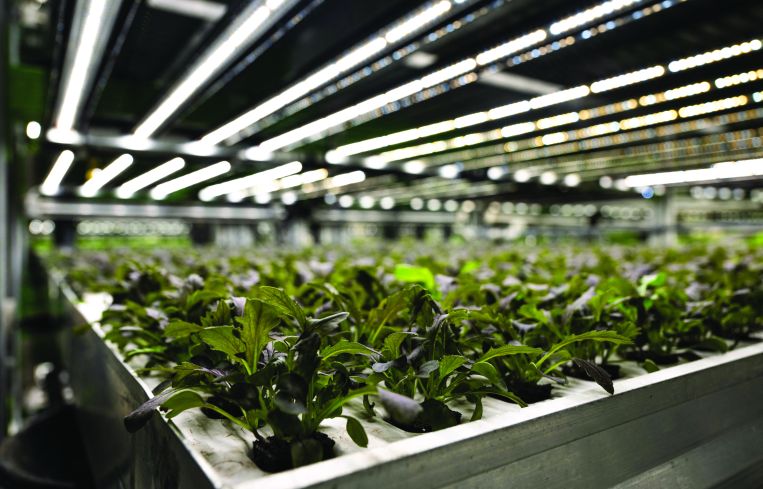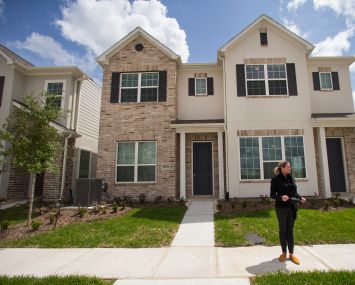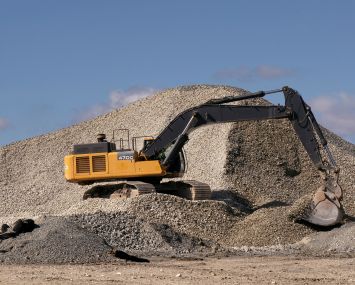Vertical Farming a Green Shoot for Struggling Commercial Space
Indoor agriculture in repurposed office and industrial properties remains hard row to hoe, but potential's there for billion-dollar asset class
By Patrick Sisson December 11, 2023 6:00 am
reprints
Located amid the often chilly Canadian prairie, Downtown Calgary isn’t typically seen as a center of agriculture.
Travel, though, to the Calgary Tower Centre, a landmark building in Alberta’s largest city, and, on the second floor, you can find tomatoes, strawberries, cucumbers and greens growing amid other tenants. A firm called AgriPlay Farms took over the space in the spring of 2022, and plans to transform additional floors, as part of an expanding effort at producing food in former commercial spaces.
“The Calgary Tower was going to be a showcase of how to grow inside of the space of a building,” Dan Houston, at the time an AgriPlay exec, told Smithsonian magazine earlier this year. “Since then, we’ve already built a much superior product.”
For certain startups as well as real estate owners and brokers, AgriPlay’s experiment and demonstration suggests one way the fallow fields of the office market — 18.4 percent of U.S. office space remains vacant, per CBRE — can be filled. What is the case, then, for replacing cubicle farms with actual indoor growing operations, often referred to as vertical farms?
One of the key economic drivers that has made indoor farming an intriguing investment has been logistics and transportation costs: Grow food closer to the consumer in, say, converted commercial property and it’s not just cheaper to ship, but it’s also fresher and more nutritious when it gets to somebody’s plate. CBRE’s U.K. research team wrote in a report this fall that there’s potential in converting existing real estate assets to vertical farming, which can then become an alternative asset class for those looking to invest in agriculture supply chains.
“Our vision is to move the farm, not the food,” said Nate Arias, head farmer for Area 2 Farms, which operates an indoor growing operation in a converted paper company plant and warehouse in Arlington, Va. “When you look broadly across the agricultural landscape, what you find is that it really has nothing to do with feeding people. It’s really more like a very brittle, multimodal transportation network.”
But transforming that vision and concept into a working, feasible business model has proved extremely difficult. The last 18 months have been especially challenging for indoor farming, an industry buffeted by inflation, a challenging financial and fundraising environment, and the long-term difficulty of making tech- and energy-intensive growing systems compete with traditional agricultural practices. A vertical farming setup costs at least 10 times as much as a typical greenhouse. As of December 2022, according to Fast Company, $1.7 billion had been invested in a sector that was still struggling to make the economics work.
More recently, AeroFarms, a leader in the field, filed for bankruptcy in July, citing significant headwinds for the industry. AppHarvest, which built a high-tech tomato greenhouse on a former mining site in Kentucky, has struggled with higher than expected costs and lower revenues. The tech sheen of the industry, which has helped contribute to hype around city-raised produce, has also been a strain on startups, expected to generate the earnings of a software company with the significantly lower margins of growing crops. There’s even been questions about the industry’s claims to save energy and grow more sustainably.
“These farms are more like infrastructure investments — it takes a long time to get things up and running,” said Marc Lev Shulman, associate director at iGrow News, an industry news source. “I think the industry hasn’t even begun to peak yet. It’s hard to transition and get growing right now.”
But there have been signs of investment and green shoots for an industry that, advocates claim, has significant secular trends behind it, especially concerns about food security. Asset management company Franklin Templeton even argues vertical farming could be a $24.1 billion global industry by 2030; the firm valued the sector at $4.1 billion in 2021. Plus, a system that can use 90 percent less water than regular farming has appeal in an era of climate change.
Firms including Square Roots and Bowery Farming have opened new locations. In February, REIT Realty Income announced a partnership with Plenty, a large AgTech firm, to provide development funding for commercial properties that will house Plenty’s indoor farms, pledging up to $1 billion, a sign of its potential as an asset class.
Realty Income CEO Sumit Roy said the REIT was attracted to the sector, likening the opportunity to distribution centers. Last fall, Plenty announced plans to invest $300 million in the coming years to build out a massive indoor growing operation in Richmond, Va., to grow Driscoll’s brand strawberries for the Northeast market and eventually produce 20 million pounds of produce annually. Realty Income will buy the land for the proposed $42 million indoor vertical farm, build it, and lease it back to the California-based grower.
“The predictability and positive unit economics of Plenty’s farms make it possible for us to utilize more traditional forms of funding, such as this strategic alliance with Realty Income,” Arama Kukutai, Plenty’s CEO, said in a statement. “This represents an advancement in the way indoor farming assets are capitalized and paves the way for their development as an asset class.”
Transitioning an office to vertical farming requires much more than cheap, open workspaces. New operations require significant investments in technology, irrigation, HVAC and lighting, and must navigate zoning and building code issues. A plan to convert office space in Downtown Chicago to vertical farming via a nonprofit called Farm Zero, announced with much fanfare in April, at one point encompassed more than a dozen different locations in the city’s Loop office district. It’s since been scaled back considerably. According to Farm Zero founder and CEO Russell Steinberg, the venture just received approval from the city for a 2,300-square-foot proof of concept on the 18th floor of 30 North LaSalle Street, which he expects to start building out in January.
Shulman hasn’t seen significant expansion in the industry lately. There have been stories of adaptive reuse playing out — he’d previously worked at Oishii, which grew a high-end Japanese varietal of strawberries indoors at a converted Anheuser-Busch distribution facility — but he thinks the industry as a whole hasn’t quite cracked the cost code, and also doesn’t have the same kind of subsidies traditional farmers get from the federal government. Many analysts have also said that these kinds of growing operations would, when they scale, prefer their own custom-built space versus adaptive reuse sites.
“The inflationary pressures that kind of hit the market for these guys has really done one primary thing, which is highlighted the business model,” Houston told Commercial Observer. He’s since left AgriPlay, and is currently working on developing a new indoor agriculture startup.
He believes most of the large vertical farms developed hardware, growing systems, and building plans based on the idea of working on a larger scale and leasing industrial property such as warehouses. In addition to creating overcomplicated tech, they also are paying a premium for more in-demand industrial space, instead of figuring out systems for cheaper, underutilized office space.
Arias, of Area 2 Farms, doubts that commercial indoor farming will suddenly become a significant tenant for office landlords desperate to fill floors lying empty due to remote and hybrid work. He thinks larger operations that try to sell to grocery chains will struggle with both higher real estate and operational costs and the lower margins needed to meet grocery chain prices.
“A farm cannot sustain what Tiffany’s pays for space,” said Arias.
Perhaps Realty Income has made the smartest real estate play possible. The industrial sites they’re renting out to Plenty will certainly be valuable assets regardless whether the tenant is involved in leafy greens or logistics.
But Arias does see a role for farms, especially small farms, within commercial real estate. Over the next nine months, Area 2 will open smaller, modular farms within a variety of buildings in the mid-Atlantic. The idea is to be something midway between tenant and amenity: The farms won’t be full-fledged tenants taking up floors and floors of space, nor will they be passive amenities like a gym or a terrace. They’ll be working, indoor agriculture operations providing fresh food to the building and surrounding neighborhood.
“They’re good for the health of the people that work or live in the building, and then they’re good for the communities around them,” he said. “Rather than spending capital on a sculpture or fountain, we can make this a draw.”


